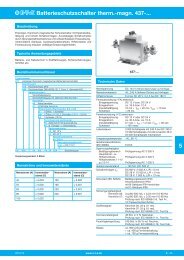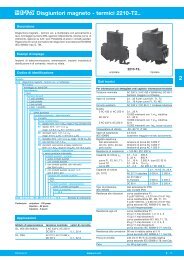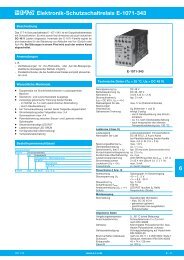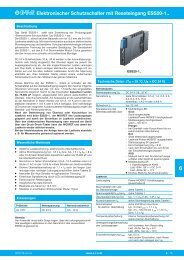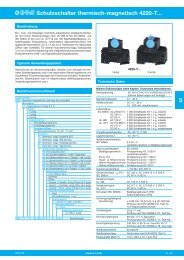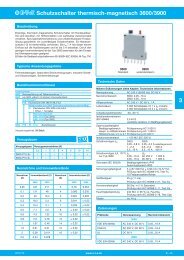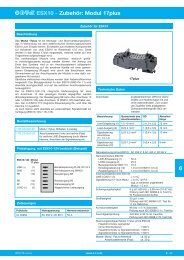Download - ETA
Download - ETA
Download - ETA
Create successful ePaper yourself
Turn your PDF publications into a flip-book with our unique Google optimized e-Paper software.
Higher<br />
d.c. voltages<br />
Switching high power at direct voltage –<br />
what are the challenges? What are the<br />
chances?<br />
Presently high d.c. voltages are<br />
being discussed in various places of<br />
technology and engineering. This does<br />
not only concern photovoltaic systems<br />
and electric cars, but also d.c. power<br />
grids for power distribution in industrial<br />
buildings. A working group in the IEC<br />
TC23 is dealing with this topic and a EU<br />
research project ENIAC shall be started.<br />
E-T-A is part of both projects.<br />
What will change on the closed contact<br />
at higher d.c. voltages?<br />
The resistance of a closed contact<br />
basically depends only on the contact<br />
force, the specific resistance and the<br />
hardness of the contact material. The<br />
power processed by the contact will then<br />
exclusively be determined by the current<br />
going over it. Hence it will be of no<br />
importance what voltage will be supplied<br />
by the supplying energy source.<br />
What is physically happening when<br />
high d.c. voltages are disconnected?<br />
If the contact opens, the conditions<br />
will change abruptly. There will be a<br />
switch arc which is indeed related to the<br />
driving voltage. This so-called plasma,<br />
a very hot gas consisting of ionised air,<br />
metal ions and electrons, will develop a<br />
certain momentum and has itself to be<br />
considered a voltage source in the circuit.<br />
The arc will only go out if the voltage it<br />
10<br />
is producing is higher than the source<br />
voltage in the circuit. So the higher the<br />
source voltage, the harder can the arc be<br />
quenched.<br />
Is it reasonable to disconnect as<br />
quickly as possible?<br />
If we disconnected an inductive circuit<br />
within an infinitely short period of time,<br />
the energy stored in the circuit would be<br />
unloaded through explosions. A switch<br />
arc kills off this energy, but the plasma<br />
life span has to be limited to a few<br />
milliseconds to keep thermal effects at<br />
bay. This will be done by additional<br />
energy removal by means of quenching<br />
sheets, outgassing chamber walls or arc<br />
extension through magnetic fields.<br />
Wouldn’t it be easier to disconnect<br />
electronically?<br />
The advantage of electronic power<br />
semi-conductors in a switching process<br />
compared to mechanical contacts is<br />
their controllability. In addition there will<br />
be no arc. The resistance of the open<br />
contact clearance can be changed in a<br />
defined time from low-resistance to highresistance.<br />
However, semi-conductors<br />
withstanding higher voltages in the OFF<br />
condition are still very expensive so that<br />
economic considerations often override<br />
technical possibilities.<br />
What are the d.c. voltages in question?<br />
For photovoltaic applications, voltages<br />
up to 800 VDC have become usual<br />
today, values up to even 1,500 VDC are<br />
being discussed. For electric mobility<br />
we are talking about values of 350 to<br />
600 VDC, for commercial vehicles even<br />
900 VDC are being discussed. Fuel cells<br />
might become the batteries of the future<br />
Our FAQ pages are meant to intensify the dialogue between<br />
manufacturer and customers. They will deal with topics arising<br />
from practice and answer relevant questions as shortly as<br />
possible and as detailed as necessary.<br />
Do you have any questions you need answer to?<br />
Send it to us – we are looking forward to hearing from you.<br />
E-T-A Elektrotechnische Apparate GmbH<br />
Keyword: Current FAQ<br />
Industriestraße 2-8, 90518 Altdorf<br />
E-Mail: faq@e-t-a.de<br />
and are suitable for all aforementioned<br />
voltages. Buildings will be equipped with<br />
regenerative systems supplying direct<br />
voltage. Therefore some experts also<br />
speculate about 380 VDC as a mains<br />
supply voltage in buildings.<br />
What is the wattage range in question?<br />
In photovoltaic systems the wattage<br />
range is from only a few kW up to several<br />
MW in solar power plants. Usual wattage<br />
for electric cars today is 40 to 60 kW. For<br />
building wiring installtion it will most likely<br />
be a few kW.<br />
What technologies are already available<br />
to switch off high d.c. voltages?<br />
Technologically we can use either purely<br />
mechanical solutions as well as electronic<br />
solutions. In addition hybrid devices seem<br />
to be very promising as they combine the<br />
advantages of both approaches.<br />
What are the chances for E-T-A?<br />
Besides opportunities in photovoltaic<br />
systems there will be new business<br />
opportunities also in the automotive<br />
industry for electric cars and on the score<br />
of HVDC networks for building installation,<br />
for data centres and telecommunications<br />
equipment.



